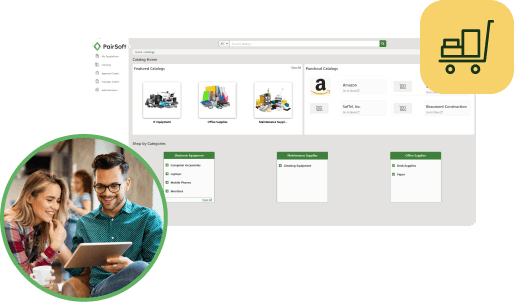
PairSoft
The strongest AP automation, document management, procurement, and fundraising automation platform for mid-market and enterprise companies with integrations to your ERP system.
View all posts by PairSoftPairSoft

In the last post, we outlined some of the basic steps in the procurement process and identified the business risks associated with each step-with a promise to take deeper dive into each step in upcoming posts.
The first step in any procurement process is when an employee recognizes the need for a particular product or service and creates a requisition. The business risk associated with this step is significant, and often underestimated: inefficiency.
Inefficiency is a hidden profit killer-in fact by some estimates, companies lose 20 to 30 percent in revenue each year due to inefficiencies.
Below are three effective ways you can mitigate your first risk in the procurement cycle—inefficiencies in the procurement process—where a need is identified, and a requisition is created.
It’s no secret that your firm’s employees rely on their mobile devices, both in and out of the office. With that in mind, it only makes sense to put the functionality they need to do their jobs on those mobile devices.
By empowering employees with the ability to create requisitions-both ad hoc and through your guided buying catalogs-from their mobile devices, they can accomplish these tasks on their schedule, whenever and wherever they happen to be working.
In addition, mobile capabilities can enable authorized personnel to view and approve requisitions from their team, speeding the process and driving efficiency.
Guided Buying Catalogs and PunchOut are two different shopping capabilities that an advance procurement software can offer users. Guided buying catalogs are an excellent way to create customized collections of selected items, often at negotiated prices with suppliers, for your company’s employees to shop from.
What’s compelling about this capability is it allows an organization to create catalogs for a specific department, programs, roles, and so on.
This allows you to better guide and control shopping with a specific vendor. Rather than sending your employees to the supplier’s website to shop, keep them within your eProcurement software application.
PunchOut is a name given to the technical protocol that allows you to directly connect to suppliers’ product catalogs from your organization’s eProcurement application. If your supplier supports PunchOut, your company’s shoppers can browse and shop in real-time on a vendor’s website-from within your eProcurement application.
Upon check out, just like in your own guided buying catalogs, your eProcurement software creates a requisition, ready for review and approval.
The beauty of this capability is it offers you and your team to have the same user experience that you would have on the supplier website because you are on the supplier own website, from within the software.
Similar to the guided catalog capability, this means when you check out, the information goes directly into the requisition within the procurement software without having to re-enter data.
Other advantages of using PunchOut are since you are shopping in real time, pricing and quantities are always up to date; you don’t have to maintain the information as you do with your own catalogs; and the requisitions are created automatically with no manual data entry. It adds up to better control, time savings, and overall efficiency.
Your procurement department works hard to establish preferred supplier agreements offering the best terms and pricing, but these can be tested when someone in the organization needs to buy something.
Guided buying catalogs are an easy and effective way to direct users to the right items, the right policies, and your preferred suppliers.
Create catalogs by vendor, location, department, or even type of item (think Office Supplies) to make it simple for shoppers to locate the items they’re looking for. Shoppers place items in their virtual shopping carts and upon check out, a requisition is created.
In addition to catalogs, many eProcurement solutions also provide the ability to save “shopping lists” made up of frequently purchased items, further streamlining the shopping task.
By limiting the purchase of many routine items to your preferred list of vendors and products, you can reign in maverick spending and reduce the need for procurement department involvement-both of which promote efficiency right from the start.
Like virtually every other vital business function, the procurement cycle benefits from a strong process framework, enabled by technology. EProcurement solutions provide that technology framework, building efficiencies throughout the procurement cycle, starting with the very first step.
Stay tuned for the next post in this series, as we continue to walk you through the steps of the procurement cycle, highlighting each stage, and uncovering ways you can maximize the value it offers you and your organization.
Talk to an expert today to uncover how your team’s procurement stacks up against the top performers in your sector.



Many organizations start with manual receipt handling, fragmented card feeds and slow AP processes. Implement AI agents to auto-capture receipts, route approvals, enable punch-out buys and post to the ERP.
Result: faster batching, fewer errors and cost savings. “This saves us hours every month.”
Many organizations face slow, paper-heavy AP and fragmented procurement that waste time and inflate costs. AI Agents can automate approvals, PO matching and record sync to improve speed, accuracy and control. Client quote: “It freed up hours and made our process reliable.”
Operational drag and rising costs slow growth: teams waste time on manual tasks, misaligned priorities and opaque processes. AI Agents help automate routine work and coordinate actions across teams. “We’ve lost time to repeats and handoffs,” says a typical client.
Companies struggle with manual procurement, fragmented approvals, and costly integrations that slow growth and obscure spend. Our AI Agents streamline requisitions, POs, and invoice matching to cut manual work and improve visibility. “We were wasting time and missing insights,” says a client.

Many teams start with fragmented PO/AP systems, manual matching and delayed financial reporting. Deploying AI agents to automate PO checks, real-time encumbrance tracking and invoice matching reduces processing time and errors, delivering live budgets and faster closes. “Finally, we can see current balances and approve instantly.”
Many companies juggle growing invoice volumes and legacy systems. They struggle with manual processes, compliance gaps and limited headcount. Our AI Agents automate integrations, enforce rules and surface exceptions. The typical outcome: faster closes and measurable ROI. “We stopped chasing invoices.”